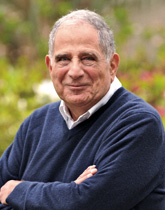
Michael and Michele ran up the stairs and rushed into my arms: "Daddy, Daddy," they cried, "there are some bad Arabs on TV." My children were only five and six years old, and it was scary for them watching their heroes—Popeye, Bugs Bunny, and Porky Pig—trouncing evil Arabs.
That was 34 years ago.
For me, their "Daddy, Daddy" cry altered my life. I would not be silent to Hollywood's reel portrayals. Silence means approval, enabling prejudices to injure a people, be they Arabs, African Americans, Jews, whomever. That's what my Carnegie Tech English professor Gladys Schmidt taught: she encouraged me to write about Hollywood's Blacklist and the Red Scare. Thanks to her, I came to admire the fearless actions of Senator Margaret Chase Smith, who stood up to Senator Joseph McCarthy when she said: "We have the right to hold unpopular beliefs, the right of independent thought."
These were values and ideals that were also upheld by my family, who had immigrated from Lebanon to the steel city of Clairton, Pa., in the early 1920s. Through their example, I learned to never vilify others, to accept people as they are, no matter their color, creed, or culture.
My earliest lessons about acceptance and equality began around the kitchen table. I would watch our neighbors—Greeks, Italians, Serbs, and our Lebanese cousins—chat in thick accents as they drank Maxwell House coffee and munched on fresh loaves of Syrian bread baked by my mom and grandmother.
Another early lesson came from my grandfather, Jacob. He worked the mills' blast furnaces, and he peddled. I was always at his side. One day he took me to Clairton's Blair neighborhood, where African Americans lived.
Although city schools were integrated, the city was segregated, and character assassinations of black people had polluted my thoughts. Because at the time, not only were America's blacks basically invisible on TV screens but Tarzan movies were teaching us that blacks, like reel American Indians, weren't civilized. So, I assumed that the home we were entering wouldn't be nearly as neat or friendly as mine. Needless to say, I was wrong.
I became more sensitive to stereotypes, but it wasn't until 1975, not long after that cartoon morning and following my tenure as a Fulbright professor at the American University of Beirut, that I begin to seriously examine Arab images in American popular culture. After I returned to the United States, some students and professors tagged me the "Arab professor," and my research proposals were labeled "propaganda." It took three years and more than 50 rejection letters before a periodical agreed to publish my first article on TV's Arabs.
Since then, I've written hundreds of articles, authored four books, and released a documentary on the issue; George Clooney even called to enlist my services as a consultant on the 2005 Academy Award-winning film Syriana.
I continue to write and consult to remind image makers to maroon the stereotype and project honest images of Arabs and Americans with Arab roots—images that are no better and no worse than others.
—Jack G. Shaheen A'57
Shaheen regularly serves as a consultant to television and motion picture companies, including DreamWorks, Warner Bros., Showtime, and Hanna-Barbera. His newest book, Guilty: Hollywood's Verdict on Arabs after 9/11 was published earlier this year.



